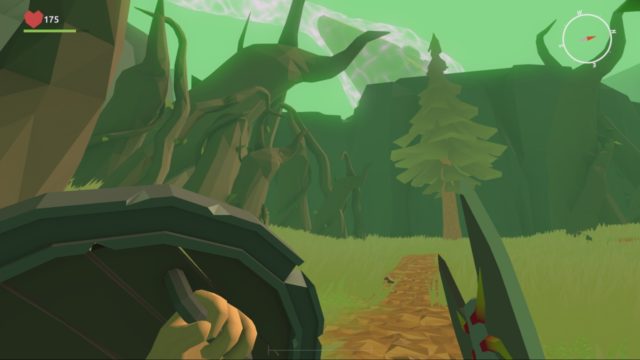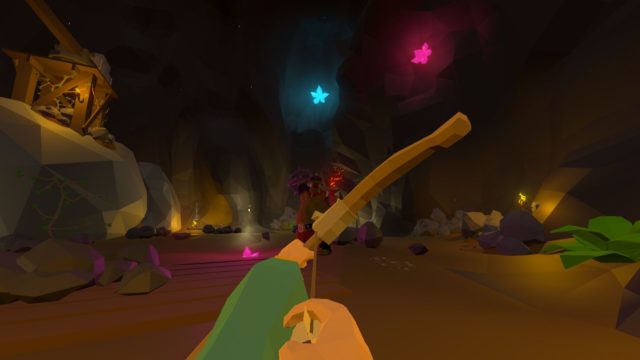Enjoyable mix of familiar concepts; charming art direction; pleasant soundtrack.
Some mechanics are a little too simple; clunky cursor driven interface; weak character animations.
While Nintendo Switch has played host to countless creative indie titles, the fact remains there are plenty of gamers who are happy to stick to big, AAA adventures like Breath of the Wild and Skyrim. Small developers often lack the means, and seemingly sometimes the interest, in developing titles whose ambition are defined more by their scope than their drive for innovation. Still, it’s always interesting to see what a small developer can accomplish when they try to compete alongside large, well-funded teams.
Windscape seemingly is an example of this commendable ambition. A glance reveals a Skyrim like adventure, in which you swing a sword through a medieval inspired world from a first-person perspective. However, playing it reveals a structure more reminiscent of a Zelda game as you explore a quasi-open world environment uncovering dungeons that mix combat and puzzle solving that end with a boss who drops a health upgrade upon their defeat. This marriage of gameplay concepts isn’t necessarily a crazy one; one could argue Breath of the Wild attempted such a union. That said, it is interesting to see a small indie developer, Dennis Witte, try something so ambitious.
Perhaps the sacrifices key to such an effort can be seen in the game’s visual style, but this really isn’t too much of a criticism of the game. Windscape features a low polygon count aesthetic with relatively simple, flat textures and, for the most part, it works. You’ll never see the inspiring vistas of Skyrim, but the world is constantly charming and the simplicity of it is consistent and feels much more intentional than a simple means of reserving resources. Unfortunately, this rings most true for just the world itself, as characters sometimes look good when standing still but reveal their limitations the moment they start moving. While somewhat disappointing, everything still feels cohesive in terms of style, even if the overall quality does take a minor hit.

The game design on-hand’s attempt to balance its Zelda and Elder Scrolls inspirations presents a similarly positive, yet slightly mixed, result. Most of the basics actually lean more heavily toward the Elder Scrolls side of the equation because, while the world isn’t truly open, the focus of your moment-to-moment and long term efforts have more in common with Bethesda’s signature series. The addition of a lock-on feature in combat is rather Zelda-ish, but circling around enemies as you flail your various swords, clubs, and hammers, complete with charge attacks for stronger blows, has much more in common with Skyrim. And, similar to that legendary title, it’s perfectly functional and often fun but a little lacking in terms of feedback and nuance. The limitations of this system are most felt in the boss encounters. While the epic showdowns often shine in Zelda titles, the more simple mechanics chosen here make them feel noticeably less epic.
Also, in keeping with the Elder Scrolls inspiration, there is a greater focus on gathering ingredients, be they from the environment or felled enemies, and using them for constructing new weapons, beneficial potions, and even magic spells. This system also works perfectly well but seems rather perfunctory as its inclusion within games like Skyrim is defined more by choice as one can opt to either construct their armory or purchase it through the sufficient amassing of wealth. The choice to have the menu entirely cursor driven instead of scrolling through selections also feels like a bit of a misstep. Still, the system is perfectly functional and never feels like a distraction even if it isn’t necessarily all that fulfilling.
While these systems scream Skyrim, the overall structure of proceedings actually has much more in common with your standard Zelda title. You assume the role of Ida, a young woman called to action after a seemingly innocuous task puts her in a storyline involving a dark force that’s causing the world, constructed of floating islands, to break apart and sink beneath the clouds. Naturally, this means working your way through a series of quests, both side and main, as you make your way across a vast and varied world tackling combat and puzzle-filled dungeons every so often. These aspects of the game also betray the inherent cracks of such an ambitious combination on a small scale budget.

Just as the combat and crafting feels somewhat limited compared to its inspirations, so too does the puzzle solving and overall dungeon construction. While the best Zelda dungeons are interconnected puzzle boxes with interlinked rooms and complex layouts, much of Windscape’s dungeon design seems focused on simple switch flipping and the oft frustrating feature that is first-person platforming. However, just as the aforementioned limitations are more minor frustrations than anger-inducing failures, the problems here don’t really inhibit the game’s overall flow so much as it just makes it slightly less satisfying.
Thankfully, fewer complaints can be made about Windscape’s sound design. While the sound effects are merely mediocre, the soundtrack is actually quite good. The music never matches the unbridled epicness of Skyrim nor does it match the iconic sounds of most Zelda games or the surprisingly atmospheric sounds of Breath of the Wild, but that isn’t really a major insult, all things considered. The classically tinged compositions adequately match the sense of exploring a fantastical world while the combat music generally serves the purpose of elevating the sense of danger, even if it isn’t quite as effective as the other tunes. The only real issue comes from the game’s efforts to change seamlessly between the more ethereal exploration music and the more intense combat tunes as there were more than a few times where I left battle only to have the music continuing it’s more elevated state of tension. Aside from these momentary distractions, the overall aural experience was quite satisfactory.
Considering Windscape is largely the product of one developer, it is actually quite an accomplishment. It ambitiously attempts to marry aspects of two of the mediums most influential action-adventure franchises and, for the most part, is able to create a very enjoyable experience. There are a number of ways in which the compromises of its premise and origin are most definitely felt, but they ultimately serve more as minor distractions. Once you move beyond these flaws, you encounter a pleasantly charming experience that feels simultaneously familiar and surprisingly fresh. Everything you’ll see and experience has been done before, but rarely has it been done simultaneously or in such a way as in Windscape. In other words, while new ground isn’t necessarily broken here, you at least get to see old ideas from a new perspective.
Nintendojo was provided a copy of this game for review by a third party, though that does not affect our recommendation. For every review, Nintendojo uses a standard criteria.




 ShareThis
ShareThis





